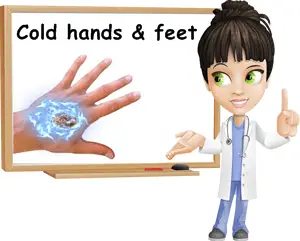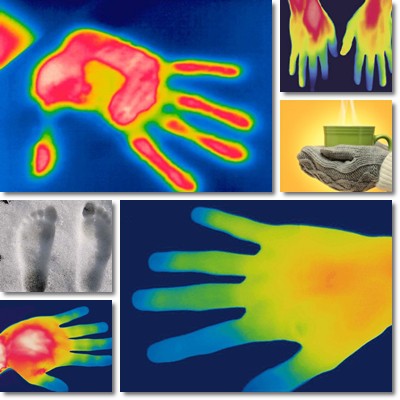Many people complain on a regular basis that they suffer from cold hands and feet either all the time or in certain situations. Simply being in a cold environment is a highly likely cause for cold hands and feet, but this is not true for all cases.
Several medical conditions and disorders having to do with blood circulation and the vascular system, hormonal balance or the nervous system and so on may lead to this sensation.
If we suffer from cold hands and feet during winter, then the low temperatures are most likely the ones to blame for us being cold in any part of our body. However, if we experience cold hands and feet all the time, even during the hot summer months, then it has to do with our body’s ability to regulate its temperature which is, for the most part, a benign issue.
Nevertheless, there are several disorders that can trigger cold hands and feet sensations as well.

What causes cold hands and feet?
Our hands and feet are full of tiny blood vessels which transport blood and oxygen to the extremities, provide nutrients for our skin and help regulate body temperature. Special nerve endings sensitive to temperature changes in the external environment send information regarding temperature in the environment to our brain.
When it’s cold outside, our brain responds by signaling blood vessels to constrict. This helps preserve heat around our internal organs, which are essential for our survival. So, basically, the blood vessels in our extremities contract in order to minimize heat loss, hence the cold hands and feet sensation.
While this function is normal during cold weather, many people experience cold hands and feet all the time. This is because of other just as subtle mechanisms which influence our body’s way of regulating its temperature.
Thyroid hormone imbalance, estrogen fluctuations (this is why women complain about cold hands and feet more often and are right to do so), diabetes, poor blood circulation, low blood pressure, low vitamin B12 or iron levels as well as several more serious medical conditions can impact our body’s temperature regulating mechanisms.
So while for some of us, tricking our body into thinking it’s not that cold outside might work, others may require a visit to the doctor and medication.
What are the causes?
Here is a list of some of the most and least common causes of cold hands and feet:
1) Exposure to cold
Not dressing warm enough when it’s cold outside or staying in a cold environment for prolonged periods of time will cause cold hands and feet. The tiny blood vessels in our hands and feet will constrict as a result of low temperature, reducing blood flow and heating capacity, hence the sensation.

2) Poor blood circulation
Wearing tight socks or shoes, shirts with tight sleeves, tight gloves and any clothing article that is tight can restrict blood circulation to our hands and feet. And because the tiny blood vessels in our hands and feet are the ones warming them up, we are more likely to have cold hands and feet.
3) Low blood pressure
Hypotension, or low blood pressure, causes an increased sensitivity to cold. Our extremities are the most sensitive areas, the first to experience circulation problems, hence the cold hands and feet sensation associated with low blood pressure.
4) Estrogen fluctuations
Fluctuating estrogen levels, estrogen dominance in particular, may cause cold hands and feet in women. Estrogen dominance is when the female hormone estrogen has a stronger effect than the counterbalancing female hormone called progesterone, which may result in cold hands and feet.
5) Hypothyroidism.
Also called underactive thyroid disease, hypothyroidism is when the thyroid gland does not produce enough thyroid hormone. Thyroid hormones travel through the blood to every part of our body and regulate the way our body uses the energy it gets from food (this is metabolism).
Not having enough thyroid hormone means our body cannot make good use of this energy which results in problems regulating body temperature such as an increased sensitivity to cold and cold hands and feet, among other symptoms.
6) Anemia, iron and vitamin B12 deficiency
A lack of dietary iron or vitamin B12, or both, will result in anemia, a condition characterized by low red blood cell count or low hemoglobin ( protein that transports oxygen) levels in the blood. This, in turn, means less oxygen and less nutrients reach our hands and feet and all other areas of the body, resulting in skin pallor and an increased sensitivity to cold.
7) Raynaud’s disease
Raynaud’s disease is characterized by poor blood flow in the hands and feet mostly and is caused by factors such as cold temperatures or stress. A common symptom is the discoloration of the extremities (toes, fingers) or other areas of the body which may become bluish or white in color.
The discoloration and cold sensitivity are caused by vasospasms (artery spasms causing constriction of the blood vessels) which decrease blood supply to the extremities and other areas of the body.
8) Atherosclerosis
Refers to plaque buildup (fat, cholesterol, calcium, etc.) on the inside of our artery walls. Over time, plaque becomes hard and narrows the blood vessels, reducing blood flow. Because one of the main functions of our blood vessels is to transport oxygen and nutrients or hormones such as thyroid hormone, all of which play a part in metabolism and temperature regulation.
9) Diabetes
The condition is known for causing blood circulation problems, thyroid problems and high blood pressure, among other complications. Blood circulation problems and thyroid imbalances can result in cold hands and feet.
10) Other causes
These include frostbites, lupus, carpal tunnel syndrome, smoking (causes blood vessels to constrict, limiting blood flow, hence the cold hands and feet sensation) or certain medication such as contraceptives, thyroid hormone therapy, high blood pressure medication, etc. may lead to cold hands and feet.
Generally, cold hands and feet are a result of feeling cold for too long. Fixing this should help fix the symptoms as well. If you suspect having cold hands and feet is more than a response to cold temperatures, it might be best to see your doctor and explain your symptoms to him or her for an accurate diagnosis and treatment plan.
10 Tips and solutions Of Cold Hands and Feet
However, as normal as it may be, having cold hands and feet is unpleasant, at the very least.
So here are a few tips and tricks to help remedy your cold hands and feet:
1) Dress warmly
Cold weather in particular asks for an appropriate dress code so wearing gloves and thick socks is ideal if you wish to avoid cold hands and feet. People with poor blood circulation should also wear socks all the time to help prevent their extremities from getting cold.
2) Avoid tight socks, gloves and shoes
Any tight clothing item or shoe can interfere with normal blood circulation. Wearing tight socks, gloves or shoes can result in cold hands and feet.
3) Eat right
Diet is also important when it comes to preventing cold hands and feet. Eating foods such as chili peppers, spinach, dark chocolate or cocoa, celery, bananas (rich in potassium) can help improve microcirculation and promote vasodilation, contributing to preventing cold hands and feet.
4) Use an infrared lamp
Whenever I come home with cold hands and feet, I turn on my infrared lamp for 10-15 minutes and place my hands and feet under it light to get warm. After a few uses I noticed my hands and feet remain warm for the rest of the night up until noon the next day. But I also don’t forget to put on socks afterwards. See benefits of infrared lamp.
5) Use warm water
Taking a hot shower or sitting with your feet in a basin with hot or warm water (water temperature depends on individual preferences) can help warm up hands and feet in a matter of minutes.
6) Move
It can happen that our hands and feet become cold because we don’t move. If you feel your extremities getting cold, stand up, stretch, walk around a little, even jump or run around or dance for a short while to help restart circulation and warm the extremities.
7) Enjoy a good massage
If you feel your hands or feet getting cold, massage them or have your significant other massage them for 10-15 minutes. This can help restart circulation and warm them up almost instantly.
8) Avoid coffee and alcohol
Despite them initially dilating blood vessels and creating a feeling of warmth in extremities and at the surface of the skin, in the capillaries, both coffee and alcohol end up worsening cold hands and feet problems because of their dehydrating effect.
9) Avoid smoking
Over time, smoking causes our blood vessels to contract which limits blood flow. This may result in cold hands and feet as well as more serious vascular problems.
10) Eat well
It is possible for cold hands and feet problems to be caused by a low calorie diet and dehydration. Maybe you have noticed how even the finest of the blood vessels in our hands become visible shortly after eating. The blood vessels start transporting nutrients to every part of our body, a process which contributes to regulating body temperature as well, among others functions.
